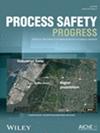基于动态仿真的加氢裂化装置定量危害与可操作性过程危害分析
IF 1
4区 工程技术
Q4 ENGINEERING, CHEMICAL
引用次数: 0
摘要
加氢裂化装置在高温、高压和靠近氢气的环境中运行,由于设备故障容易发生火灾和爆炸事故。因此,识别和分析风险因素至关重要。基于动态仿真的定量危害和可操作性(HAZOP)研究可以有效、有目的地量化偏差和后果,减少安全分析结果的冗余。通过动态仿真引入时间参数,更真实地反映系统发生故障时的动态特性。本文以某炼油公司实际加氢裂化装置吸稳系统工艺流程为例,借助Aspen Plus V11和Aspen Plus Dynamics V11软件对压力、温度、液位偏差进行稳态和动态模拟,完成基于动态模拟的定量HAZOP分析。本文章由计算机程序翻译,如有差异,请以英文原文为准。
Dynamic simulation-based quantitative hazard and operability process hazard analysis for a hydrocracking unit
A hydrocracking unit operates at high temperature, high pressure, and near hydrogen, which can be susceptible to fire and explosions accidents due to equipment failure. Therefore, it is essential to identify and analyze the risk factors. The dynamic simulation-based quantitative hazard and operability (HAZOP) study can effectively and purposefully quantify deviations and consequences as well as reduce the redundancy of safety analysis results. Furthermore, the time parameter is introduced through dynamic simulation, which reflects more realistically the dynamic characteristics of the system in the event of a fault. In this paper, we take the process flow of the absorbing-stabilizing system of an actual hydrocracking unit in a refining company as an example and carry out steady-state and dynamic simulations for the deviations of pressure, temperature, and liquid level with the help of Aspen Plus V11 and Aspen Plus Dynamics V11 software to complete the dynamic simulation-based quantitative HAZOP analysis.
求助全文
通过发布文献求助,成功后即可免费获取论文全文。
去求助
来源期刊

Process Safety Progress
工程技术-工程:化工
CiteScore
2.20
自引率
10.00%
发文量
99
审稿时长
6-12 weeks
期刊介绍:
Process Safety Progress covers process safety for engineering professionals. It addresses such topics as incident investigations/case histories, hazardous chemicals management, hazardous leaks prevention, risk assessment, process hazards evaluation, industrial hygiene, fire and explosion analysis, preventive maintenance, vapor cloud dispersion, and regulatory compliance, training, education, and other areas in process safety and loss prevention, including emerging concerns like plant and/or process security. Papers from the annual Loss Prevention Symposium and other AIChE safety conferences are automatically considered for publication, but unsolicited papers, particularly those addressing process safety issues in emerging technologies and industries are encouraged and evaluated equally.
 求助内容:
求助内容: 应助结果提醒方式:
应助结果提醒方式:


